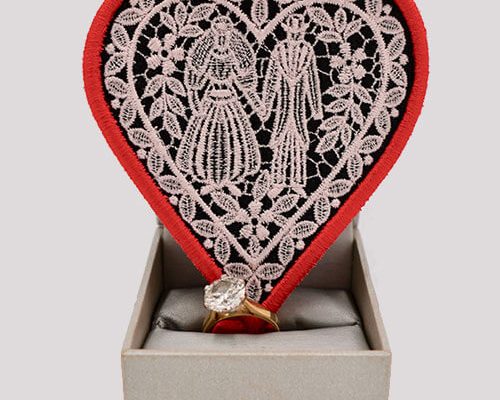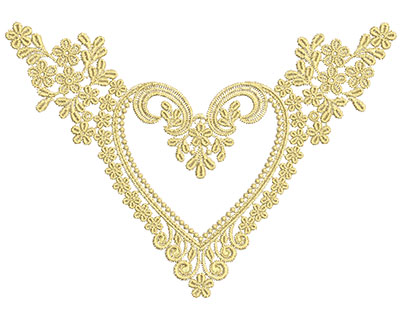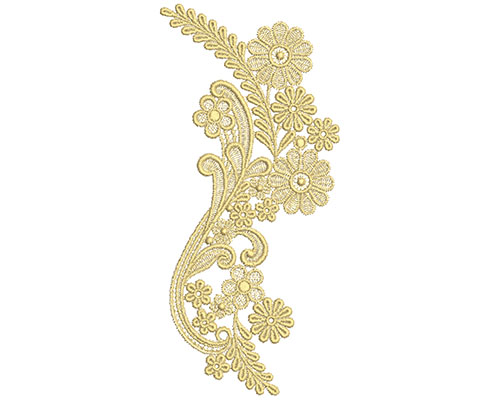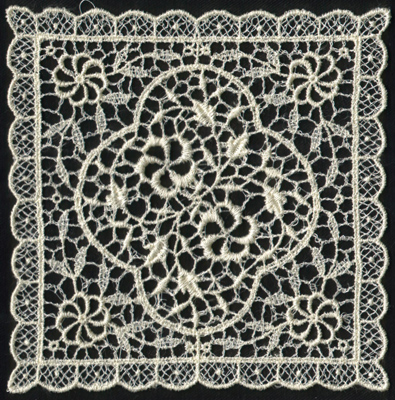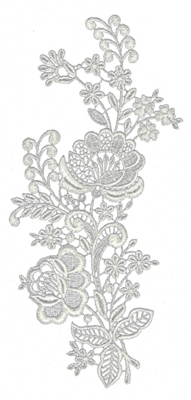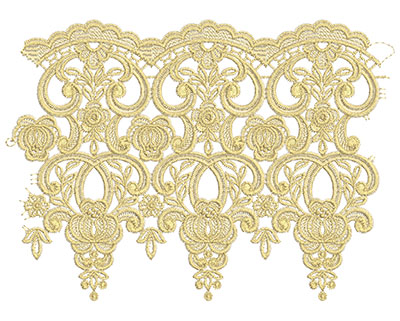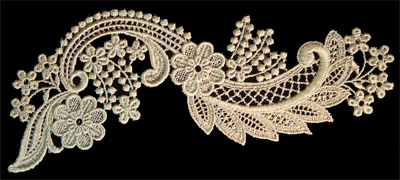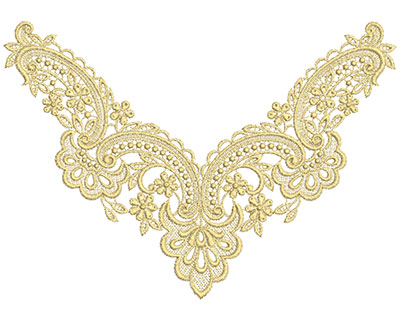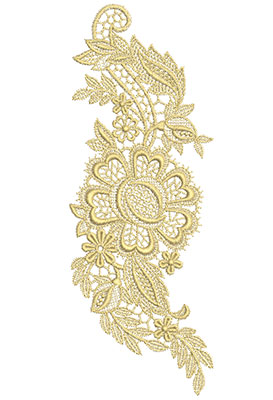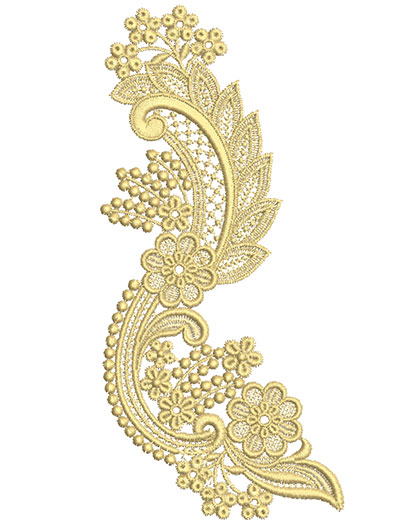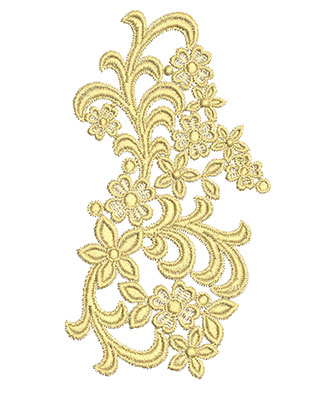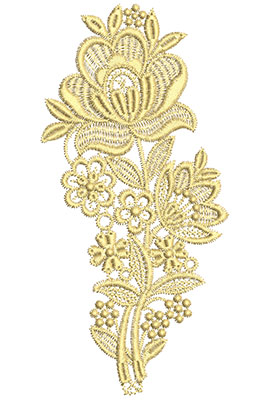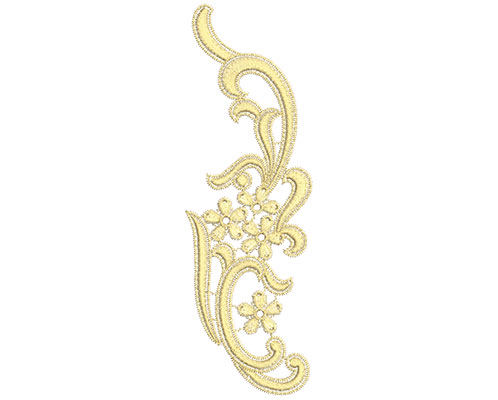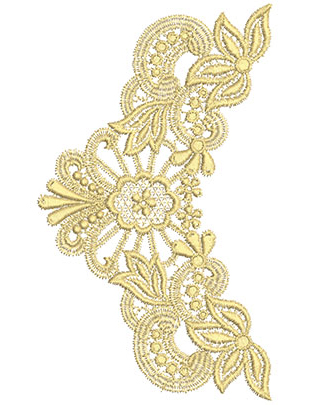Everyone loves chiffon, tulle, and light, fluffy fabrics, but when it comes to embroidery, who loves to actually embroider on them?

There are many times in which you would love to put some of your creativity to use for a bridal, cocktail, and other special occasions, but when you try, you end up with a wadded mess and ruined fabric.
Chiffon, satin, tulle, and other sheer fabrics can be challenging to sew, much less embroider. These are some delicate fabrics, so let’s tackle a tricky problem. Let’s discuss suggestions to make embroidering these fabrics easier and how to get the best results possible. Let’s look at which designs do and do not work, how the thread and machine used affects the finished results, and what types of aids you can use.
What Are Tulle, Chiffon, Organza, and Satin Fabrics?
Tulle Fabric
Tulle is created using fine silk or cotton thread wound on bobbin lace bobbins and twisted together by hand, effectively creating a fish net.
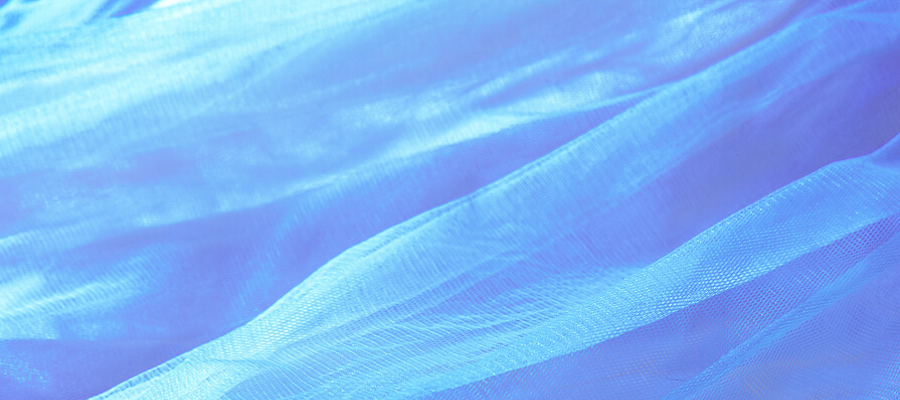
The advantage of the bobbinet was that it did not unravel since it was knotted and, if torn, could be repaired.
Chiffon Fabric
Chiffon is an airy and light fabric. Originally created in silk, this is a woven fabric that uses highly twisted threads woven with the thread twist alternating back and forth in warp and weft. The twist in the crepe yarns puckers the fabric slightly in both directions after weaving, giving it some stretch and a slightly rough feel.

Since this is a woven fabric, it will fray and unravel and needs to have rolled seams to finish.
Organza Fabric
Organza is a woven fabric originally made of silk. Its quality is also measured by holes per inch.

Like chiffon, it uses tightly twisted threads; they are combed and treated with acid to give a stiffer feel. Organza is now made from polyester but requires additional care.
Satin Fabric
Satin is not sheer, but it is tricky! It is also a weave but really a weave on top of another weave. Scattered in between warp threads, weft threads skip over several warps to produce a smooth layer on the top of the fabric with longer jumps of shiny thread.

This produces a matte backside and a luxurious top side.
Considerations When Embroidering On Tulle, Chiffon, Organza, and Satin Fabrics
When designing a machine embroidery design or pattern for sheer fabrics and execution, there are many things to consider. Remember that even with the best planning, there may be occasions when it is just not possible, but we’re going to get you a good foundation. Let’s look at the main points to remember when planning your project.
Embroidery Designs For Sheer Fabrics
You’ve thought of your project, your fabric or garment, and you are planning your design. Of course you know that embroidering on chiffon is nothing like denim!
Here are three considerations for you as you plan!
1) Stitch density – Having a stitch-dense-filled design works on denim and other fabrics, but light and airy fabrics like tulle do not have enough material to support them.
Choose designs that are not filled with tatami or satin but rather designed for lace. Interested in learning more about embroidering freestanding lace? Click here to a tutorial and tips!
Lace designs are planned so a border is filled with a light zigzag fill. These shapes are connected with connectors so that the stitching has a good structure.
These vintage lace designs are an excellent example of light designs for light fabric. Click here to see all vintage embroidery lace designs. (Did you know our lace designs were created in the 1950s and manually crafted one stitch at a time by European Schiffli Masters?)
2) Lines – You may have a design that has long lines, stems, or other elements. Make sure to choose longer running stitches and avoid long lines of satin as these require many stitches to complete, and the structure of the tulle or other fabric will not support them. When the piece is released from the hoop, long satin lines will pucker and ripple, ruining your effect.
3) Size – Opt for smaller designs or objects connected with running stitches is always smarter. Think small or small groupings when planning for tulle, chiffon, or satin. Don’t plan to put that 80,000 stitch back patch on it.
Interested in creating your own gorgeous embroidery designs for sheer fabrics? Check out our Advanced Freestanding Lace Embroidery Digitizing Lesson by clicking here.
Considerations When Machine Embroidering On Light Fabrics
You have your fabric and now your design. You’ve taken into account the density and size; now what?
You will have some more considerations waiting for you at the hooping station and machine. Sheer fabrics are not used to being roughed up and require a soft touch when handling. Let’s look at hooping, floating, and stabilizing these fabrics.
Hooping Light Fabrics
- You can easily hoop tulle chiffon and satin in magnetic hoops, but you will need to be gentle when hooping in standard hoops.
When choosing a hoop, use the smallest hoop you can to fit your design. Want more tips & tricks for embroidery hooping? Click here to learn more.
- Larger hoops will let the fabric travel. Don’t stretch them too tightly, or you will tear organza, chiffon, and tulle, and be sure to leave a little slack when using standard hoops.
- Satin will get damaged if you squish the fabric between the bottom and top hoop. With satin, particularly when you crush the fabric, you are actually moving the thread out of alignment, which will cause disfigurement. Use tissue paper or paper towel to prevent hoop burn.
Want to hoop without the struggle? Learn more about our Echidna Hooping Stations by clicking here. With a non-slip frame, powerful magnets, and angled frame (just to name a few), why not save the frustration?
Floating Light Fabrics
- Floating (when you hoop only the stabilizer) your fabric is possible, but remember that pinning or stitching the fabric to stabilizers will leave marks. Your goal is to leave no trace or marks behind.
Stabilizers For Light Fabrics
-
Stabilizer is a MUST when working on light fabrics but not cutaway or tearaway for chiffon and tulle. The goal is to support the material while stitching and help keep the fabric from slipping around (there is a trick coming up below…). Let’s look at each fabric.
- Satin: for most satin projects, you can use no-show mesh but remember to consider what the garment is for; a prom dress with a square of cutaway stabilizer under the design will absolutely show and will ruin the flow of the fabric.
- Tulle/Organza: is now a nylon or polyester lace, so you will want to avoid iron away stabilizers as they could require an iron setting too hot for the fabric. A heavyweight wash away is excellent for this type of work, or two layers of medium or lightweight if you don’t have heavy weight.
- Chiffon: can go either way! If you can wash out the stabilizer, the wash-away stabilizer is an excellent choice since it lets the fabric remain supple. If you must use a “nonwash away” stabilizer, a no-show mesh trimmed close is a perfect choice.

NEVER use tear away stabilizer on chiffon fabric as this will create a crunchy stitch out on really soft material. Click here for more tips & tricks about embroidery stabilizer.
- Iron Away Stabilizer: this is a wonderful product, but unless you know the content of your material and if it can tolerate the heat needed to remove it, it’s best to use water-soluble.
- Water Soluble: there are many weights of water-soluble stabilizers; remember there is a difference between a topper (plastic wrap-like feel) and a heavyweight (cloth-like feel). Generally, the fabric-like materials can leave residue, and the plastic-like films can leave a sticky gel if not washed out thoroughly.
Embroidery Thread For Light Fabrics
- Most use polyester thread because it is durable and versatile, but why not try rayon? Anyone who has worn a rayon garment knows they are soft and luscious, and rayon thread is the same. While not as durable, rayon thread is perfect for laces and soft, airy stitch-outs.
Interested in learning more about different types of machine embroidery threads and when to use them? Click here for all you need know.
Embroidery Machine Speed For Light Fabrics
- Machine Speed – Modern machines are capable of up to 1200 stitches (per minute), but we’re going to dial it waaaaay back. Yes, it takes a lot more time, but lightweight fabrics will contract when you stitch at high speed since they cannot handle the stress. SLOW is the way to GO!
Set your embroidery machine to the lowest speed setting for best-embroidered results. Wondering how else your machine speed affects your embroidery results? Click here to learn more.
Tricks and Tips for Sheer Fabric In Machine Embroidery
Well, we’ve got our plans set, but here are some handy tips to keep in mind when working with these fabrics. Remember that Free Standing Lace has its own set of stabilizing rules. Today we are discussing embroidery on clothing, veils, and other soft flowing projects.
- Temporary Adhesive spray- a VERY light spray on your fabric of temporary spray will help it to adhere to the stabilizer. Don’t use too much as the residue, even though temporary, can remain. Always remember LESS IS MORE.
Want to learn more about using adhesives with your embroidery? Click here to read our Embroidery Adhesives article to explain the pros and cons of different kinds available and to help you master using them without headaches & problems.
- When cleaning polyester or nylon sheer fabrics of stabilizer or adhesive residue, try following a thorough rinse in warm water with a bit of alcohol. Remember to follow manufacturer instructions for the stabilizer, and then if that does not remove all reside a little isopropyl alcohol on a cotton ball and tease away the rest.
- When rinsing away the stabilizer, start by trimming away excess stabilizer (save it for later or make stabilizer spray!) and then immerse in warm water, gently moving the fabric. Try to only rinse the section with the embroidery. If it’s not too delicate, hold the fabric under a stream of running water.
Remember that some wash-away stabilizers have cellulose fibers, so make sure not just to rinse next to the stitching. Once dried, you may not be able to remove residue.
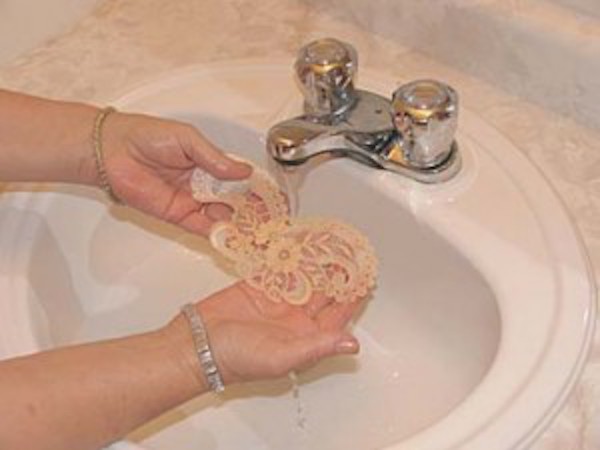
- Occasionally we will have a project which cannot move; wetting your fingertip and touching the stabilizer lightly, and then laying down the tulle and allowing it to dry will tack the net down. Be VERY careful, though; too much water will dissolve your stabilizer.
- Use tissue paper to protect your tulle or other fabric when hooping.
Tip: Lay a piece of tissue over the netting and hoop, then cut away a window for your embroidery to help prevent marks and scuffs.

Conclusion: Don’t Be Afraid To Embroider Sheer Fabrics
Lots of information here, right? The only way you can find out if this delicate embroidery process is for you is to try it out. We suggest starting with used bridal veils, smaller pieces of sheer fabrics, or thrift store materials (make sure they’re newer as poorly preserved netting will not be easy to work on) until you feel comfortable to venture out onto important garments.
Here are a few things to remember:
- Know your fabric fiber content, and get to know each fabric.
- Be gentle! These are delicate fabrics, and they need a light hand.
- Work slowly. Slow your machine down. It’s better to stitch longer and have a usable piece.
- Be mindful of the embroidery design you choose. Use lighter, less stitch-intensive designs; for longer lines, use a running stitch.
There is much more to learn when using these gentle fabrics, but this will get you started in the right direction! Happy stitching!
P.S. Don’t forget to check out our almost 600 truly vintage embroidery lace designs by clicking here to accentuate your next embroidery garment today perfectly!


